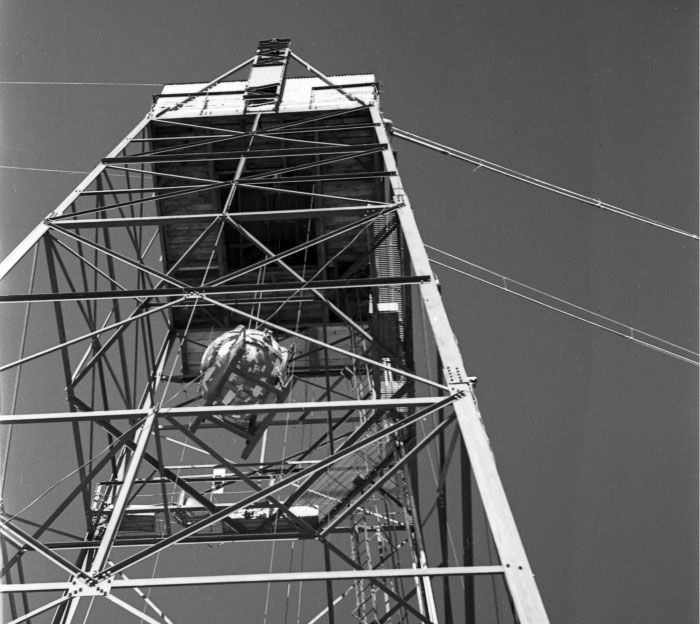The start of the nuclear age
By Rachel Bronson | July 16, 2015

Seventy years ago today on July 16, 1945, scientists saw “the end of the world”—how one of those scientists’ descendants described to me the first ever-nuclear blast. Code-named Trinity, the blast occurred in a remote part of the New Mexico desert outside of Los Alamos National Laboratory.
Maj. Gen. Leslie Groves, the military commander overseeing the country’s race for the bomb, radioed back to Washington in coded message, saying the “results seem satisfactory and already exceed expectations.” Robert Oppenheimer, the director of Los Alamos National Laboratory, where the bomb was designed, thought about spiritual passages from Indian scripture. The nuclear age had begun.
The Manhattan Project, as the effort was called, ultimately brought together 150,000 scientists from across the country at a cost of around $2 billion. The goal was to beat the Nazis in a race to create an atomic bomb. The scientists sequestered at Los Alamos worked devilishly long hours, often with the sinking feeling that they were falling behind in this life-and-death scientific race. In fact, they were significantly and miraculously ahead.
The goal for some of the scientists was to create a weapon so monstrous it would end major-power wars. And, in this, they accomplished their goal. For others the goal was to beat the Germans, an end that was reached independent of the creation of an atomic bomb. And for others still, the goal was to take science to its logical conclusion, releasing the enormous potential of nuclear power to achieve amazing advancements while controlling its dangers. Today, radiation therapy kills cancer cells, and nuclear energy is powering the New Horizon spacecraft that passed Pluto yesterday.
Exactly three weeks after the Trinity test, Little Boy and Fat Man, the first and only two nuclear bombs to be dropped during wartime, were loaded into planes and dispatched not for Germany but for Japan to put an end to World War Two.
Almost immediately, the scientists who had seen the end of the world began educating the public and policy leaders about the unprecedented destructiveness of nuclear weapons. In 1939, Albert Einstein wrote to President Roosevelt that nuclear weapons had the potential to take out whole ports; by the time of Little Boy and Fat Man, nuclear weapons could vaporize whole cities. Today, as Steven Starr, Lynn Eden and Theodore Postol have written, one 800-kiloton bomb dropped over Manhattan would create a fire zone covering a total area of 90 to 150 square miles. Russian intercontinental ballistic missiles carry hundreds of such warheads.
Trinity scientists and others started newsletters and writing campaigns. The Bulletin of the Atomic Scientists, where I work, published its first newsletter in December 1945. Seventy years later, that organization continues to engage scientists, policy makers and the public on existential threats.
Those early scientists also helped launched international convenings like Pugwash to advocate for disarmament. Policy leaders took up their challenge and over the course of 70 years created a web of arms control and disarmament agreements that have successfully lessened the number and spread of nuclear weapons.
Today, 70 years later, we have much to celebrate and much to fear. The spread of nuclear weapons has slowed considerably thanks to an arms control architecture built over decades, particularly the 1970 Non-Proliferation Treaty (NPT). The number of nuclear weapons has also decreased dramatically, from a high of around 70,000 in 1986, to around 17,000 today. And this week’s historic agreement between the United States and Iran shows that diplomatic acumen and scientific prowess can still come together to help limit and delay the spread of nuclear weapons.
Still, today’s world remains exceedingly dangerous. In January of this year, the Bulletin of the Atomic Scientists moved the hands of the iconic Doomsday Clock from 5 to 3 minutes to midnight. A recent Economist magazine cover decried the dawning of “A New Nuclear Age.” Every nuclear power is spending lavishly to upgrade its atomic arsenal, new nuclear powers do not have the same communication and transparency channels to help avoid misperceptions, and relations between Russia and the United States, the two largest nuclear states, are spiraling quickly downward. The New Yorker described today’s reality as one of “nuclear drift.”
A new round of arms control efforts, and an updating of existing arms control regimes, is very much needed. The Iran negotiations provide hope that progress can be made in updating and rethinking the nuclear security architecture. Seventy years ago, scientists stood in the desert to witness the unleashing of the world’s most powerful weapon. Today, 70 years later, we have successfully slowed the spread of nuclear weapons, reduced their numbers, and limited their use. Seventy years from now, will we be able to say the same thing?
Together, we make the world safer.
The Bulletin elevates expert voices above the noise. But as an independent nonprofit organization, our operations depend on the support of readers like you. Help us continue to deliver quality journalism that holds leaders accountable. Your support of our work at any level is important. In return, we promise our coverage will be understandable, influential, vigilant, solution-oriented, and fair-minded. Together we can make a difference.














